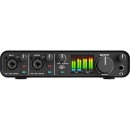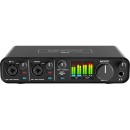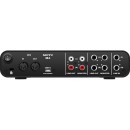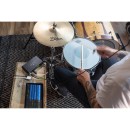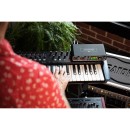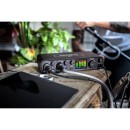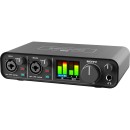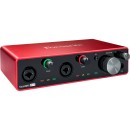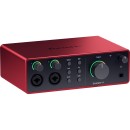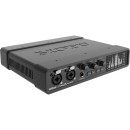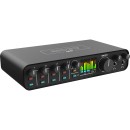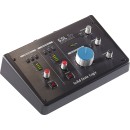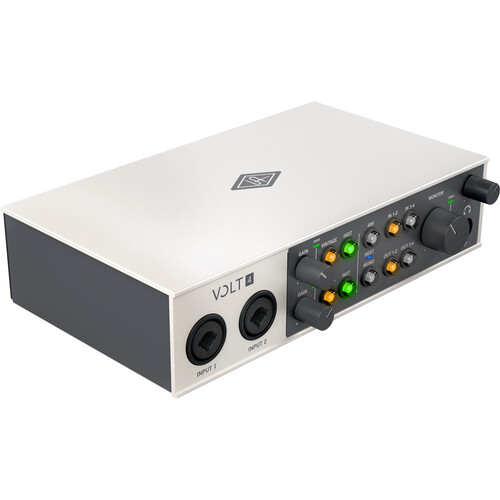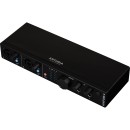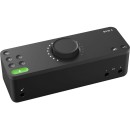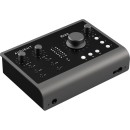MOTU M4 USB-C Audio-MIDI Interface: A Comprehensive Review
- 4-input/4-output USB-C audio interface
- 24-bit/192 kHz resolution
- ESS Sabre32 Ultra DAC technology
- Ultra-low latency performance
- Direct hardware monitoring with mix knob
- Two mic/line/guitar inputs with preamps and phantom power
- Two balanced 1/4-inch TRS line inputs
- Two balanced 1/4-inch TRS line outputs
- MIDI I/O for connecting keyboards and other MIDI gear
- Full-color LCD display for level monitoring
- Loopback functionality for live streaming and podcasting
- Bus-powered via USB-C connection
- Comes with MOTU Performer Lite and Ableton Live Lite software
In-Depth Analysis of the MOTU M4 USB-C Audio-MIDI Interface
The MOTU M4 USB-C Audio-MIDI Interface is a high-performance, compact interface designed for musicians, producers, and audio engineers who demand superior sound quality and versatile connectivity. Featuring ESS Sabre32 Ultra™ DAC technology, the M4 offers industry-leading 120 dB dynamic range and pristine audio clarity. This ensures that every detail of your recordings and playback is captured with remarkable precision.
Equipped with four inputs and four outputs, the M4 provides ample connectivity options for various audio sources, including microphones, instruments, and line-level devices. The two high-quality mic preamps with individually switchable 48V phantom power make it easy to connect condenser microphones and other high-end recording gear. Additionally, the M4 includes a dedicated hardware monitoring system with ultra-low latency, allowing for real-time tracking and mixing without any perceptible delay.
The M4 also features a full-color LCD screen that provides clear, at-a-glance metering for all inputs and outputs, giving users instant visual feedback on their audio levels. MIDI I/O ports are included for seamless integration with MIDI controllers, synthesizers, and other MIDI-capable equipment. With its robust build quality, user-friendly interface, and cross-platform compatibility (macOS, Windows, iOS, and Android), the MOTU M4 is an ideal solution for any recording setup, whether in a professional studio or a home environment.
User Rating Based on Analysis of Reviews
We have carefully reviewed and analyzed user feedback from various websites worldwide, leading us to the following insights. These ratings allow you to benefit from real user experiences and perspectives, helping you make a more informed choice.
Purchase Value
87% of users found the MOTU M4 USB-C Audio Interface to be a great value for money, highlighting its competitive pricing compared to other interfaces with similar features. Many appreciated the high-quality preamps and low-latency performance, which are often found in more expensive models. Users noted that the interface provided excellent sound quality and a robust build, making it a worthwhile investment for both amateur and professional audio creators.
13% of users expressed dissatisfaction with the purchase value, feeling that the interface did not meet their expectations in terms of performance relative to its price. Some users encountered issues with the software or compatibility with certain operating systems, which they felt detracted from the overall value. Additionally, a few users mentioned that other brands offered similar features at a lower cost.
Sound Quality
92% of users were highly satisfied with the sound quality provided by the MOTU M4. They praised its clear and transparent audio output, which significantly improved their recording and playback experience. Many users appreciated the pristine sound and the high-quality DA converters, which they felt allowed for professional-level recordings without colorization of the input signal.
8% of users were not satisfied with the sound quality, mainly due to individual preferences or specific issues with their setup. Some reported that the sound output did not meet their expectations for clarity or depth, which may be attributed to mismatched equipment or improper calibration. A few users experienced noise or interference that they believed was related to the interface.
Build Quality
90% of users praised the MOTU M4 for its solid build quality. They appreciated the sturdy metal chassis, which provided durability and a premium feel. Many users noted that the interface could withstand the rigors of both studio use and on-the-go recording, and liked the high-quality knobs and buttons that enhanced the user experience.
10% of users were not satisfied with the build quality, citing issues such as loose knobs or buttons that felt flimsy. A few users experienced physical defects, such as poorly fitted parts or cosmetic damage. While these cases were relatively rare, they impacted the overall perception of the interface's durability for those affected.
Ease of Use
85% of users found the MOTU M4 user-friendly, highlighting its straightforward setup process and intuitive controls. Many appreciated the clear labeling and layout of the interface, which made it easy to navigate without prior technical experience. Users felt that the accompanying software was well-designed and complemented the hardware effectively, adding to the convenience of use.
15% of users found the MOTU M4 challenging to use, often due to difficulties with the initial setup or software installation. Some users mentioned that the documentation was not detailed enough, requiring them to seek additional help online. Others experienced configuration issues with certain DAWs, which took time to troubleshoot and resolve.
Software Compatibility
78% of users were satisfied with the software compatibility of the MOTU M4, reporting smooth integration with major digital audio workstations (DAWs) and operating systems. They appreciated the stable drivers and the ease of configuring the interface with their existing audio setups, which facilitated seamless recording and editing sessions.
22% of users encountered software compatibility issues, particularly with less common DAWs or older operating systems. Some reported driver instability or lag during sessions, which affected their workflow. A number of users also pointed out the lack of dedicated apps or support for mobile devices, limiting the interface's versatility for certain use cases.
Latency Performance
91% of users were highly satisfied with the latency performance of the MOTU M4, noting its low-latency monitoring capabilities and efficient driver performance. This aspect was particularly praised by musicians and producers who require real-time audio feedback for recording and mixing, as it allowed them to work without noticeable delay.
9% of users experienced latency issues, which they attributed to their specific computer configurations or the need for additional optimization. Some users found that latency increased when using multiple plugins or high sample rates, which disrupted their workflow and required adjustments to mitigate.
Customer Support
74% of users were satisfied with the customer support provided by MOTU, appreciating the responsive and helpful service they received when encountering issues with the M4. Many users found the support team knowledgeable and capable of resolving their problems efficiently, which increased their overall satisfaction with the product.
26% of users were dissatisfied with customer support, reporting slow response times and unhelpful resolutions to their inquiries. Some users felt that their issues were not adequately addressed, leading to prolonged downtime and frustration. A few also mentioned that the support resources available online were insufficient for troubleshooting their specific problems.
Portability
89% of users appreciated the portability of the MOTU M4, noting its compact size and lightweight design. This made it easy to transport and ideal for mobile recording setups or small studio spaces. Users liked that it could easily fit into a backpack or gear bag, making it convenient for musicians and producers on the move.
11% of users found the portability of the MOTU M4 lacking, primarily due to the need for additional cables or power sources in certain setups. Some users mentioned that while the size was compact, the interface did not feel as rugged as other portable options, causing concern about potential damage during transport.
Input/Output Options
82% of users were satisfied with the input/output options offered by the MOTU M4, highlighting the versatility provided by the combination of XLR, line, and MIDI inputs. Users enjoyed the ability to connect a range of instruments and devices, which made the interface suitable for various recording scenarios.
18% of users felt that the input/output options were limited, particularly for more complex audio setups. Some users desired additional inputs or outputs to accommodate larger sessions, while others found the lack of digital I/O options a drawback for integrating with certain studio equipment.
Design
88% of users appreciated the design of the MOTU M4, praising its sleek, modern look and intuitive control layout. The interface's aesthetic appeal and practical design elements, such as the large volume knob and clear metering displays, were frequently mentioned as positive aspects that enhanced the user experience.
12% of users were not satisfied with the design, citing minor ergonomic issues such as cramped control spacing or less intuitive button placement. Some users felt that the visual design could be improved for easier navigation during sessions, particularly in low-light environments.
Durability
86% of users were satisfied with the durability of the MOTU M4, noting its robust construction and resilience to wear and tear. Many users felt confident in its long-term performance, even with regular use in demanding environments. This aspect added to the perceived value and reliability of the interface.
14% of users expressed concerns about durability, often due to personal experiences with wear-related issues or defective units. Some users reported problems with connectors or components becoming loose over time, which affected their confidence in the interface's longevity.
Aesthetic Appeal
84% of users were pleased with the aesthetic appeal of the MOTU M4, appreciating its sleek, understated design that blended well with other studio equipment. Users liked the clean lines and professional appearance, which contributed to a positive perception of the product's quality.
16% of users were less impressed with the aesthetic appeal, feeling that the design was too plain or lacking distinctive features. Some users suggested that more vibrant color options or unique design elements could enhance the interface's visual presence.
Setup Process
80% of users found the setup process for the MOTU M4 straightforward and hassle-free. They appreciated the clear instructions and minimal steps required to get the interface up and running. The straightforward installation of drivers and software contributed to a smooth start for most users.
20% of users encountered challenges during the setup process, often related to driver installation or compatibility with their specific operating systems. Some users reported issues with outdated instructions or the need for manual troubleshooting to resolve initial setup problems.
Connectivity
81% of users were satisfied with the connectivity options of the MOTU M4, highlighting the versatile USB-C connection that provided stable data transfer. Users appreciated the convenience of a single cable for power and data, which simplified their setup and reduced cable clutter.
19% of users had issues with connectivity, primarily related to USB-C compatibility with older systems or the need for adapters. Some users experienced intermittent connection problems, which they attributed to cable quality or port compatibility issues.
Driver Stability
75% of users were pleased with the stability of the drivers provided with the MOTU M4, noting that they facilitated consistent and reliable performance across different applications. Users appreciated the regular updates and support from MOTU to maintain optimal driver functionality.
25% of users experienced driver stability issues, which impacted their usage of the interface. Some reported crashes or glitches during sessions, requiring frequent updates or reinstallations to resolve. Others found the drivers less stable on certain operating systems, leading to frustration.
User Interface
83% of users were satisfied with the user interface of the MOTU M4, praising its intuitive design and easy-to-navigate controls. Users found the interface straightforward, with clearly labeled inputs and outputs that simplified the recording process.
17% of users found the user interface lacking, mainly due to personal preferences or specific workflow needs. Some users desired more customizable options or advanced features that were not available with the current interface design.
Preamp Quality
89% of users were impressed with the preamp quality of the MOTU M4, noting the clean and transparent sound that enhanced their recordings. Users appreciated the low noise floor and ample headroom provided by the preamps, which allowed for detailed and dynamic audio capture.
11% of users were not satisfied with the preamp quality, often citing noise issues or insufficient gain for certain microphones. Some users found that the preamps did not perform as well as those in higher-end interfaces, though they acknowledged the trade-off for the price point.
Firmware Updates
77% of users appreciated the availability of firmware updates for the MOTU M4, which improved functionality and addressed common issues. Users valued the proactive approach taken by MOTU to enhance the interface's performance over time through updates.
23% of users were dissatisfied with the firmware update process, often due to difficulties in installation or lack of clear instructions. Some users experienced problems after updates, such as changes in settings or new bugs, which required further troubleshooting.
Overall Satisfaction
88% of users expressed overall satisfaction with the MOTU M4, praising its performance, build quality, and value. Users felt that it met or exceeded their expectations in most areas, making it a highly recommended choice for those seeking a reliable audio interface.
12% of users were not fully satisfied with their experience, often due to isolated issues with specific features or compatibility. While most found the product to be satisfactory, these users highlighted areas for improvement to enhance the overall user experience.
Metering Accuracy
84% of users were satisfied with the metering accuracy of the MOTU M4, noting the clear and precise visual feedback provided during recording and playback. Users appreciated the detailed meters that allowed for effective monitoring of audio levels.
16% of users encountered issues with metering accuracy, often related to discrepancies between the interface's meters and those in their DAW. Some users found the visual feedback less responsive or precise than expected, impacting their ability to accurately monitor levels.
Output Quality
90% of users were impressed with the output quality of the MOTU M4, highlighting its clear and detailed sound reproduction. Many users noted the high-quality headphone and line outputs, which provided accurate audio representation for mixing and monitoring.
10% of users were not satisfied with the output quality, often due to specific issues with their setup or preferences. Some users experienced faint noise or distortion, which they attributed to external factors or mismatched equipment rather than the interface itself.
In this section, we will delve into the detailed specifications of the MOTU M4 USB-C Audio-MIDI Interface, highlighting its features, strengths, and weaknesses. Our thorough examination will help you understand whether this product meets your needs.
Pros:
- High-quality audio performance with ESS Sabre32 Ultra DAC technology.
- Ultra-low latency performance, making it suitable for real-time monitoring.
- Comprehensive metering with full-color LCD display for precise level monitoring.
- USB-C connectivity ensures fast data transfer and compatibility with modern devices.
- Sturdy build quality and compact design, ideal for portable use.
- Loopback functionality for easy live streaming and podcasting.
Cons:
- Limited to 4 inputs and 4 outputs, which may not be sufficient for larger setups.
- No built-in DSP effects, which could limit flexibility for some users.
- Only USB bus-powered, which might not be ideal for all scenarios.
- No ADAT or S/PDIF connectivity, limiting expansion options.
General
| Channels of I/O | Analog: 4 Inputs / 4 Outputs |
|---|---|
| Maximum Sampling Rate | 192 kHz / 24-Bit |
| Number of Microphone Inputs | 2 Preamps |
| Input Level Adjustment | 2x Knob |
| Expansion Slots |
The MOTU M4 USB-C Audio-MIDI Interface offers a range of specifications that make it a versatile tool for audio recording and production. Show More
Channels of I/O: The M4 features 4 analog inputs and 4 outputs. This configuration allows users to connect multiple audio sources simultaneously, making it ideal for recording instruments, vocals, or other audio signals. With the ability to manage four inputs and outputs, users can create complex mixes and monitor various audio channels during the production process.
Maximum Sampling Rate: The interface supports a maximum sampling rate of 192 kHz and a bit depth of 24-bit. This high sampling rate ensures that the audio captured is detailed and clear, providing a professional level of sound quality. Higher sampling rates and bit depths allow for more nuanced recordings, making it especially beneficial for intricate musical projects where fidelity is key.
Number of Microphone Inputs: The M4 is equipped with 2 microphone preamps, which are essential for connecting dynamic or condenser microphones directly to the interface. Having two preamps allows for the simultaneous recording of vocals or instruments, facilitating multi-tracking without needing additional equipment.
Input Level Adjustment: The interface includes adjustable input level knobs for both microphone inputs. This feature enables users to fine-tune the gain levels for each input, ensuring optimal recording levels and reducing the risk of distortion or clipping during the recording process.
Expansion Slots: The M4 does not have expansion slots, meaning that the interface is designed as a standalone unit without the option for additional hardware upgrades. This could limit future expandability for users who might want to add more inputs or outputs down the line, but it also simplifies the setup and use for those who require a straightforward recording solution without the complexity of modular additions.
Overall, the MOTU M4 provides a robust set of features tailored for high-quality audio production, making it a valuable asset for musicians, podcasters, and audio engineers alike.
Signal Processing
| Pad | |
|---|---|
| Gain/Trim Range | Mic Inputs: 0 dB to +60 dB Line/Hi-Z Inputs: 0 dB to +57 dB |
| High-Pass Filter | |
| Solo/Mute |
The MOTU M4 USB-C Audio-MIDI Interface features several important specifications that impact its performance and usability in audio recording and production.Show More
Pad: The absence of a pad feature means that the interface does not have a built-in option to reduce the input signal level for very loud sources. This can be a consideration for users who frequently work with high-output microphones or instruments, as they may need to manage levels using external equipment to avoid distortion.
Gain/Trim Range: The gain range for mic inputs spans from 0 dB to +60 dB, while line and Hi-Z inputs have a range from 0 dB to +57 dB. This flexibility allows users to optimize the input signal levels for various sources. A higher gain setting is particularly useful for low-output microphones, ensuring they capture sound effectively without unwanted noise. Conversely, higher gain for line and Hi-Z inputs allows for better management of louder sources, making this feature essential for achieving clear and balanced recordings.
High-Pass Filter: The absence of a high-pass filter means that the interface does not provide the option to cut low-frequency sounds, which can help reduce unwanted rumble or low-end noise. Users may need to rely on software solutions or external processing to manage low frequencies in their recordings.
Solo/Mute: The lack of solo and mute functions indicates that users cannot isolate or silence individual channels directly from the interface. This might limit flexibility during monitoring, as users may need to adjust levels through their DAW or utilize additional hardware to achieve similar functionality.
Overall, these specifications highlight the M4's straightforward design, catering to users who prioritize direct input management while recording.
Connectivity
| Analog Audio I/O | 2x Combo XLR-1/4" TRS Balanced/Unbalanced Mic/Line/Hi-Z Input 2x 1/4" TRS Balanced Line Input 1x 1/4" TRS Unbalanced Headphone Output 4x 1/4" TRS Balanced Line Output (DC-Coupled) 4x RCA TS Unbalanced Line Output |
|---|---|
| Phantom Power | 48 V, Selectable On/Off (Selectable on Individual Inputs) |
| Digital Audio I/O | |
| Host Connection | 1x USB-C |
| Host Connection Protocol | USB 2.0 |
| USB (Non-Host) | |
| Sync I/O | |
| Network I/O | |
| MIDI I/O | 1x DIN 5-Pin Input 1x DIN 5-Pin Output |
The MOTU M4 USB-C Audio-MIDI Interface features a variety of specifications designed to cater to both amateur and professional audio needs. Show More
Starting with Analog Audio I/O, the interface includes multiple input and output options. It has two combo XLR-1/4" TRS inputs that can handle balanced or unbalanced microphone, line, or Hi-Z signals, allowing versatility for different audio sources. Additionally, there are two balanced line inputs and a headphone output, ensuring you can monitor your audio with clarity. The four balanced line outputs provide DC-coupled connections, which are useful for sending control voltages to external devices. The inclusion of RCA outputs further expands connectivity options for various audio gear. The interface also offers 48V phantom power that can be selectively turned on or off for individual inputs, making it suitable for powering condenser microphones.
On the digital side, the M4 does not feature digital audio I/O, which may limit integration with certain digital audio systems. Its host connection utilizes a single USB-C port operating under the USB 2.0 protocol, providing reliable and fast data transfer to your computer or recording device. However, it does not support USB non-host configurations, meaning it cannot act as a USB hub for other devices.
The interface lacks sync I/O and network I/O options, which could impact synchronization with other audio hardware in more complex setups. However, it does include MIDI I/O, featuring a 5-pin DIN input and output, enabling integration with MIDI equipment such as keyboards or controllers, adding to the flexibility of the interface for music production. Overall, the specifications of the MOTU M4 make it a robust solution for various audio recording and playback tasks.
Performance
| Frequency Response | Mic Inputs: 20 Hz to 20 kHz +0/-0.1 dB Line, Hi-Z Inputs: 20 Hz to 20 kHz ±0.15 dB Line Inputs: 20 Hz to 20 kHz ±0.07 dB Line Outputs: 20 Hz to 20 kHz +0/-0.1 dB |
|---|---|
| Maximum Input Level | Mic Inputs: +10 dBu (Min Gain) Line/Hi-Z Inputs: +16 dBu (Min Gain) Line Inputs: +18 dBu (Min Gain) |
| Maximum Output Level | Line Outputs: +16 dBu (Balanced) Line Outputs: +9.5 dBu (Unbalanced) Headphone Outputs: +12.5 dBu |
| Impedance | Mic Inputs: 2.65 Kilohms Line Inputs: 2 Megohms Hi-Z Inputs: 1 Megohm Line Outputs: 100 Ohms |
| Dynamic Range | Mic Inputs: 115 dBA Line/Hi-Z Inputs: 114 dBA Line Inputs: 115 dBA Line/Monitor Outputs: 120 dBA RCA Outputs: 119 dBA Headphone Outputs: 115 dBA |
| THD+N | Mic Inputs: < -97 dB / < 0.0014% Line/Hi-Z Inputs: < -100 dB / < 0.001% Line Inputs: < -106 dB / < 0.0005% Line/Monitor Outputs: < -110 dB / < 0.00032% RCA Outputs: < -105 dB / < 0.00056% Headphone Outputs: < -110 dB / < 0.0003% |
| EIN | Mic Inputs: -129 dB A-Weighted (150-Ohm Source, Max Gain) |
The MOTU M4 USB-C Audio-MIDI Interface is designed with a range of specifications that cater to professional audio needs. Show More
Frequency Response refers to the range of audio frequencies the device can accurately reproduce. For the MOTU M4, the frequency response for various inputs and outputs is impressively wide, spanning from 20 Hz to 20 kHz. This range encompasses the full spectrum of human hearing, ensuring that both low and high frequencies are captured and reproduced with precision. The small deviation in dB values indicates a very flat response, meaning there is minimal coloration of the audio signal.
Maximum Input Level indicates the highest signal level that can be accepted without distortion. The M4 supports different maximum input levels for mic, line, and Hi-Z inputs, allowing for flexible connectivity with various audio sources. Higher values here mean that the interface can handle louder signals without introducing unwanted noise or distortion, which is crucial for capturing high-quality audio from instruments or vocal performances.
Maximum Output Level specifies the peak output levels of the interface's outputs, including balanced and unbalanced line outputs and headphone outputs. Higher output levels allow for driving studio monitors or headphones effectively, ensuring that the audio can be delivered with clarity and punch, even at higher volumes.
Impedance is a measure of how much resistance the interface presents to incoming signals. The MOTU M4 features various impedances for its inputs and outputs, tailored for different types of devices. For instance, mic inputs have a lower impedance, which is suitable for matching with microphones, while line and Hi-Z inputs have higher impedances that are optimal for instruments and line-level signals.
Dynamic Range represents the difference between the smallest and largest possible signals that can be processed without distortion. With dynamic ranges in the range of 114 to 120 dBA across different inputs and outputs, the M4 can handle both quiet and loud sounds effectively, providing an accurate and detailed audio experience.
Total Harmonic Distortion plus Noise (THD+N) measures the level of distortion and noise introduced by the interface during signal processing. The MOTU M4 boasts very low THD+N values, indicating that it can reproduce audio signals with high fidelity and minimal distortion, which is essential for professional audio applications.
Equivalent Input Noise (EIN) quantifies the inherent noise of the microphone inputs. A lower EIN value indicates a quieter preamp, which is crucial for capturing delicate sounds without interference from the interface itself. The M4's EIN of -129 dB shows that it is exceptionally quiet, making it ideal for capturing nuanced audio details.
Overall, these specifications highlight the MOTU M4's capability to deliver high-quality audio performance suitable for both studio and live environments.
Digital Audio
| Sample Rates | Up to 192 kHz |
|---|---|
| Sample Rate Conversion | |
| Bit Depths | 24-Bit |
| Latency | Zero-Latency Direct Monitoring2.5 ms at 96 kHz (Dependent on Buffer Size, Input to Output) |
| Sync Sources | Internal |
The MOTU M4 USB-C Audio-MIDI Interface offers impressive audio specifications that cater to both professional and aspiring musicians. Show More
Sample Rates: This interface supports sample rates up to 192 kHz, which determines the number of samples of audio carried per second. Higher sample rates allow for better audio quality and more detail, making them ideal for high-fidelity recordings and professional applications. The ability to work at such high sample rates ensures that the M4 can capture the nuances of sound, which is especially important in music production.
Sample Rate Conversion: The specification indicates that the M4 does not utilize sample rate conversion. This means that the audio data is processed at its original sample rate without alterations. While some interfaces use sample rate conversion to accommodate different audio sources, the absence of this feature ensures that the signal remains pure, preserving the integrity of the audio for the best possible sound quality.
Bit Depths: The MOTU M4 operates at 24-bit depth, which refers to the resolution of the audio data. A higher bit depth allows for a greater dynamic range, meaning it can capture quieter sounds without distortion and handle louder sounds more effectively. This is crucial for professional recordings, as it enables more detailed sound reproduction and allows for more headroom in mixing.
Latency: The M4 boasts zero-latency direct monitoring, which is particularly beneficial for musicians during recording sessions. This feature allows users to hear their input signals in real-time without any delay, allowing for a more natural performance experience. The specified latency of 2.5 ms at 96 kHz (dependent on buffer size) indicates that the interface can achieve very low latency, ensuring that musicians can record and monitor their performances without disruptive delays.
Sync Sources: The M4 provides internal sync sources, which refer to the method the device uses to synchronize audio playback and recording. Using an internal sync source allows for reliable timing across all connected devices, which is essential for maintaining the integrity of a recording session, especially when multiple tracks or devices are involved. This feature supports a seamless workflow, enabling musicians to focus on their creativity without worrying about timing issues.
Overall, these specifications make the MOTU M4 a robust and reliable choice for anyone looking to achieve high-quality audio recordings.
Audio Storage & Playback
| Memory Card Slot |
|---|
The MOTU M4 USB-C Audio-MIDI Interface does not include a memory card slot, which means it relies solely on USB connectivity for data transfer. This feature is common in many audio interfaces, focusing on providing a streamlined, efficient workflow for users who typically record and process audio directly on their computers. Without a memory card slot, users will need to manage their audio files and projects through their computer's storage, which is usually more than sufficient for most home and professional studio applications.Show More
The absence of a memory card slot also simplifies the device's design, making it more compact and reducing potential points of failure. Users can connect the M4 directly to their computer via USB-C, allowing for low-latency audio performance and easy integration with DAW software. This design choice is particularly beneficial for musicians and producers who prioritize mobility and ease of use when setting up their recording environment. Overall, while the lack of a memory card slot may limit some standalone recording capabilities, it aligns with the M4's purpose as a powerful, versatile interface designed for computer-based audio production.
Compatibility
| OS Compatibility | macOS 10.11 or Later Windows 7 or Later 9 or Later |
|---|---|
| Processor Requirement | Mac: 1 GHz Intel PC: 1 GHz Intel Pentium |
| RAM Requirements | 2 GB, 4 GB Recommended |
| Required Hardware | Available USB 2.0 Port USB Cable (Included) |
| Internet Connection | Required for Software/Driver Download |
The MOTU M4 USB-C Audio-MIDI Interface is designed to provide high-quality audio and MIDI capabilities for both Mac and Windows users. Its OS compatibility indicates that the device works seamlessly with macOS versions starting from 10.11 and Windows versions from 7 onwards. This wide range of compatibility ensures that it can be integrated into various setups, catering to both new and older systems.Show More
Processor requirements specify that both Mac and PC users need at least a 1 GHz Intel processor for optimal performance. This ensures that the device can handle audio processing tasks without lag or issues, which is crucial for real-time audio production and monitoring. Additionally, the RAM requirements indicate that while 2 GB is the minimum, 4 GB is recommended. More RAM allows for smoother operation and better multitasking capabilities, especially when working with multiple audio tracks or plugins.
The required hardware section emphasizes the need for an available USB 2.0 port, which the M4 connects through. This connectivity is essential for data transfer between the interface and your computer. The USB cable is included, simplifying setup right out of the box. Lastly, an internet connection is necessary for downloading the software and drivers, which are vital for the interface to function correctly with your computer. This requirement ensures users can access the latest updates and support for their audio interface, enhancing its overall usability and performance.
Power
| Power Requirements | USB Bus Power |
|---|
The MOTU M4 USB-C Audio-MIDI Interface is designed to be user-friendly and efficient, with its power requirements being a key aspect of its functionality. The specification indicates that the device is powered via USB Bus Power. This means that it draws power directly from the computer or other compatible USB power sources rather than requiring an external power supply. Show More
This feature simplifies setup, making it ideal for musicians and producers who need a portable solution. By relying on USB Bus Power, users can connect the MOTU M4 to their laptops or desktops without worrying about additional cables or power adapters, enhancing mobility for on-the-go recording and production. The efficiency of USB power also tends to be reliable, ensuring that the interface can deliver consistent performance without interruptions caused by power supply issues.
Physical
| Anti-Theft Features | Kensington Security Slot |
|---|---|
| Dimensions | 8.25 x 4.25 x 1.75" / 20.96 x 10.79 x 4.45 cm (Chassis Only) |
| Weight | 1.6 lb / 0.7 kg |
The MOTU M4 USB-C Audio-MIDI Interface includes several practical features that enhance its functionality and security. One such feature is the Anti-Theft Features, which incorporates a Kensington Security Slot. This slot allows users to attach a compatible security cable, helping to prevent theft and unauthorized removal of the device, making it ideal for use in public or shared spaces.Show More
In terms of Dimensions, the M4 measures 8.25 x 4.25 x 1.75 inches (20.96 x 10.79 x 4.45 cm) for the chassis alone. These compact dimensions make it easy to integrate into any studio setup or to transport for live performances, ensuring that it won't take up excessive space while still providing robust audio capabilities.
The Weight of the interface is 1.6 lb (0.7 kg), which contributes to its portability. A lightweight design is essential for musicians and audio professionals who often need to move their equipment between locations, allowing for easy setup and teardown without the burden of heavy gear. Overall, these specifications highlight the M4's user-friendly design and practicality for both studio and on-the-go use.
Packaging Info
| Package Weight | 2.15 lb |
|---|---|
| Box Dimensions (LxWxH) | 10.6 x 7.3 x 2.8" |
The MOTU M4 USB-C Audio-MIDI Interface features a Package Weight of 2.15 lb, which indicates the overall weight of the unit when packaged for shipping. This weight is relatively light, making the interface portable and easy to transport for musicians, producers, or anyone needing a reliable audio solution on the go. A lighter package can also reduce shipping costs and improve convenience for users who may frequently move their gear between locations.Show More
The Box Dimensions (LxWxH) of 10.6 x 7.3 x 2.8 inches provide insight into the physical size of the product when contained in its retail packaging. These dimensions suggest a compact design that is user-friendly and space-efficient, allowing it to fit easily into equipment bags or studio setups without taking up excessive space. The compact size is particularly advantageous for mobile setups or small studio environments where space is at a premium. Overall, these specifications reflect the MOTU M4's design focus on portability and practicality for audio professionals.
Customer Images
Customer Questions
How do I set up the MOTU M4 for the first time?
To set up the MOTU M4, first download and install the latest drivers from the MOTU website. Connect the M4 to your computer using the provided USB-C cable. After installation, configure your DAW to use the M4 as the audio input and output device.
Why is my computer not recognizing the MOTU M4?
Ensure that you have installed the latest drivers from the MOTU website. Check that the USB-C cable is properly connected and try using a different USB port. Restart your computer and the M4. If the issue persists, try using a different USB cable.
How do I update the firmware on the MOTU M4?
Download the latest firmware update from the MOTU website. Follow the instructions provided in the firmware update package. Typically, this involves running a firmware update utility with the M4 connected to your computer.
What should I do if there is no sound coming from my MOTU M4?
Check your audio settings in your DAW or operating system to ensure the M4 is selected as the output device. Verify that the volume levels on both your computer and the M4 are turned up. Ensure your speakers or headphones are properly connected.
How can I reduce latency with the MOTU M4?
To reduce latency, go to your DAW's audio settings and lower the buffer size. Ensure you have the latest drivers and firmware installed. Additionally, close any unnecessary applications running in the background.
Why is my microphone input not being detected?
Ensure your microphone is properly connected to one of the M4's input channels. Check that the input gain knob is turned up and the correct input channel is selected in your DAW or recording software. Verify that phantom power is enabled if your microphone requires it.
How do I use the MIDI ports on the MOTU M4?
Connect your MIDI device to the MIDI IN or OUT ports on the M4. In your DAW, configure the MIDI settings to recognize the M4 as the MIDI input and/or output device. Ensure your MIDI device is powered on and set to the correct mode.
Why is there a delay in my recording playback?
This delay, known as latency, can be minimized by lowering the buffer size in your DAW's audio settings. Ensure your computer meets the system requirements and that you are using the latest drivers and firmware.
Can I use the MOTU M4 with both Mac and PC?
Yes, the MOTU M4 is compatible with both Mac and PC. Ensure you download and install the correct drivers for your operating system from the MOTU website.
How do I connect external speakers to the MOTU M4?
Connect your external speakers to the main outputs on the back of the M4 using appropriate cables (TRS or XLR). Ensure the speakers are powered on and configured correctly. Adjust the volume using the main output knob on the M4.
Comparison
← SWIPE THE TABLE TO SEE MORE →
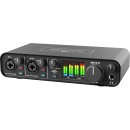
MOTU M4 |
VS | ||||||||||
|---|---|---|---|---|---|---|---|---|---|---|---|
| Analog: 4 Inputs / 4 Outputs |
Channels of I/O |
Analog: 2 Inputs / 2 Outputs |
Analog: 4 Input / 4 Output at 192 kHz |
Analog: 4 Inputs / 4 Outputs at 192 kHz |
Analog: 8 Inputs / 12 Outputs Digital: 10 Inputs / 10 Outputs |
Analog: 6 Inputs / 4 Outputs |
Analog: 2 Inputs / 4 Outputs at 192 kHz |
Analog: 4 Inputs / 4 Outputs |
Analog: 4 Input / 4 Output Digital: Digital I/O |
Analog: 4 Inputs / 4 Outputs at 96 kHz |
10 Input / 14 Output |
| 192 kHz / 24-Bit | Maximum Sampling Rate | 192 kHz / 24-Bit | 192 kHz / 24-Bit | 192 kHz / 24-Bit | 192 kHz / 24-Bit | 192 kHz / 24-Bit | 192 kHz / 24-Bit | 192 kHz / 24-Bit | 192 kHz / 24-Bit | 96 kHz / 24-Bit | 96 kHz / 32-Bit |
| 2 Preamps | Number of Microphone Inputs | 2 Preamps | 2 Preamps | 2 | 2 Preamps | 4 Preamps | 2 Preamps | 2 Preamps | 2 | 4 Preamps | 2 Preamps |
| 2x Combo XLR-1/4" TRS Balanced/Unbalanced Mic/Line/Hi-Z Input 2x 1/4" TRS Balanced Line Input 1x 1/4" TRS Unbalanced Headphone Output 4x 1/4" TRS Balanced Line Output (DC-Coupled) 4x RCA TS Unbalanced Line Output |
Analog Audio I/O |
2x Combo XLR-1/4" TRS Balanced/Unbalanced Mic/Line/Hi-Z Input 1x 1/4" TRS Unbalanced Headphone Output 2x 1/4" TRS Balanced Line Output (DC-Coupled) 2x RCA TS Unbalanced Line Output |
2x Combo XLR-1/4" TRS Balanced/Unbalanced Mic/Line/Hi-Z Input (Front Panel) 2x 1/4" TRS Balanced Line Input 4x 1/4" TRS Balanced Line Output 1x 1/4" TRS Unbalanced Headphone Output (Front Panel) |
2x Combo XLR-1/4" 3-Pin Balanced/Unbalanced Mic/Line/Hi-Z Input (Front Panel) 2x 1/4" TRS Balanced/Unbalanced Line Input 4x 1/4" TRS Balanced/Unbalanced Line/Monitor Output 1x 1/4" TRS Headphone Output (Front Panel) |
2x Combo XLR-1/4" TRS Balanced/Unbalanced Mic/Line/Hi-Z Input (Front Panel) 6x 1/4" TRS Balanced Line Input 10x 1/4" TRS Balanced Line Output (DC-Coupled) 1x 1/4" TRS Unbalanced Headphone Output (Front Panel) |
4x Combo XLR-1/4" TRS Balanced/Unbalanced Mic/Line/Hi-Z Input 2x 1/4" TRS Balanced Line Input 2x 1/4" TRS Unbalanced Headphone Output 4x 1/4" TRS Balanced Line Output (DC-Coupled) |
2x Combo XLR-1/4" TRS Balanced/Unbalanced Mic/Line/Hi-Z Input 2x 1/4" TRS Balanced Monitor Output 4x RCA TS Unbalanced Line Output 2x 1/4" TRS Unbalanced Headphone Output |
2x Combo XLR-1/4" TRS Balanced/Unbalanced Mic/Line/Hi-Z Input (Front Panel) 2x 1/4" TRS Balanced Line Input 2x 1/4" TRS Balanced Monitor Output 1x 1/4" TRS Unbalanced Headphone Output (Front Panel) |
2x Combo XLR-1/4" TRS Balanced/Unbalanced Mic/Line/Hi-Z Input (Front Panel) 2x 1/4" TRS Balanced/Unbalanced Line Input 4x 1/4" TRS Balanced Line/Monitor Output 2x 1/4" TRS Unbalanced Headphone Output (Front Panel) |
4x Combo XLR-1/4" TRS Balanced Mic/Line Input (Pin 2 Hot) 1x 1/4" TS Unbalanced Hi-Z Input (Front Panel) 4x 1/4" TRS Balanced Line Output (Tip Hot) 2x 1/4" TRS Unbalanced Headphone Output |
2x Combo XLR-1/4" 3-Pin Mic/Line Input 1x 1/4" TS Unbalanced Hi-Z Input (Front Panel) 2x 1/4" TRS Balanced Insert Send 2x 1/4" TRS Balanced Insert Return 4x 1/4" TRS Balanced Monitor Output 1x 1/4" TRS Headphone Output (Front Panel) 1x 1/8" / 3.5 mm TRS Headphone Output (Front Panel) |
| 1x USB-C | Host Connection | 1x USB-C | 1x USB-C | 1x USB-C | 1x USB-C (Class-Compliant) | 1x USB-C | 1x USB-C | 1x USB-C | 1x USB-C | 1x USB-C | 1x USB-C |
| macOS 10.11 or Later Windows 7 or Later 9 or Later |
OS Compatibility |
macOS 10.11 or Later Windows 7 or Later 9 or Later |
macOS 10.12 or Later Windows 7 or Later |
macOS Windows |
macOS 10.11 or Later Windows 10 13.5 or Later |
macOS 10.11 or Later (64-Bit Only) macOS 10.13 or Later (64-Bit Only) Windows 10 or Later (64-Bit Only) |
macOS 10.11 macOS 10.12 macOS 10.13 macOS 10.14 macOS 10.15 Windows 8.1 Windows 10 |
macOS 10.14 or Later Windows 10 |
macOS 10.13 or Later (64-Bit Only) Windows 8.1 or Later (64-Bit Only) |
macOS 10.7.5 or Later Windows 7 or Later (32-/64-Bit) |
Windows macOS |
| USB Bus Power | Power Requirements | USB Bus Power | USB Bus Power | USB Bus Power, USB Power Adapter (Not Included) | AC/DC Power Adapter (Included) | AC/DC Power Adapter (Included) | USB Bus Power | AC/DC Power Adapter (Included) or USB Bus Power | USB Bus Power | USB Bus Power | USB Bus Power |
